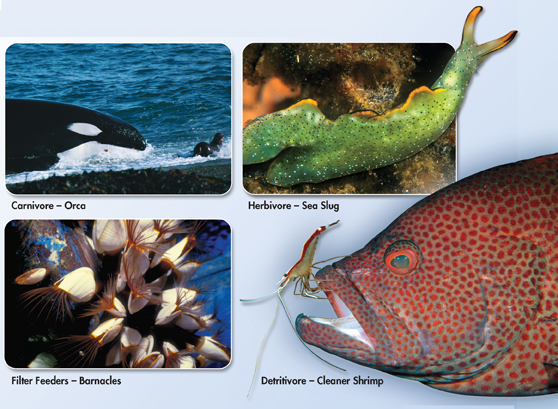Herbivores  Herbivores eat plants or parts of plants in terrestrial and aquatic habitats. Some herbivores, such as locusts and cattle, eat leaves, which is not an easy way to make a living! Leaves don't have much nutritional content, are difficult to digest, and can contain poisons or hard particles that wear down teeth. Other herbivores, including birds and many mammals, specialize in eating seeds or fruits, which, in contrast to leaves, are often filled with energy-rich compounds.
Herbivores eat plants or parts of plants in terrestrial and aquatic habitats. Some herbivores, such as locusts and cattle, eat leaves, which is not an easy way to make a living! Leaves don't have much nutritional content, are difficult to digest, and can contain poisons or hard particles that wear down teeth. Other herbivores, including birds and many mammals, specialize in eating seeds or fruits, which, in contrast to leaves, are often filled with energy-rich compounds.
BUILD Vocabulary
WORD ORIGINS The word part -vore comes from the Latin verb vorare, which means “to devour.”
Nutritional Symbionts Recall that a symbiosis is the dependency of one species on another. Symbionts are the organisms involved in a symbiosis.  Many animals rely upon symbiosis for their nutritional needs.
Many animals rely upon symbiosis for their nutritional needs.
▸ Parasitic Symbionts Parasites live within or on a host organism, where they feed on tissues or on blood and other body fluids. Some parasites are just nuisances, but many cause serious diseases in humans, livestock, and crop plants. Parasitic flatworms and roundworms afflict millions of people, particularly in the tropics.
▸ Mutualistic Symbionts In mutualistic relationships, both participants benefit. Reef-building corals depend on symbiotic algae that live within their tissues for most of their energy. Those algae capture solar energy, recycle nutrients, and help corals lay down their calcium carbonate skeletons. The algae, in turn, gain nutrition from the corals' wastes and protection from algae eaters. Also, animals that eat wood or plant leaves rely on microbial symbionts in their guts to digest cellulose.

FIGURE 27–1 Obtaining Food The orca, sea slug, barnacles, and cleaner shrimp obtain their food in different ways.
Table of Contents
- Formulas and Equations
- Applying Formulas and Equations
- Mean, Median, and Mode
- Estimation
- Using Measurements in Calculations
- Effects of Measurement Errors
- Accuracy
- Precision
- Comparing Accuracy and Precision
- Significant Figures
- Calculating With Significant Figures
- Scientific Notation
- Calculating With Scientific Notation
- Dimensional Analysis
- Applying Dimensional Analysis




